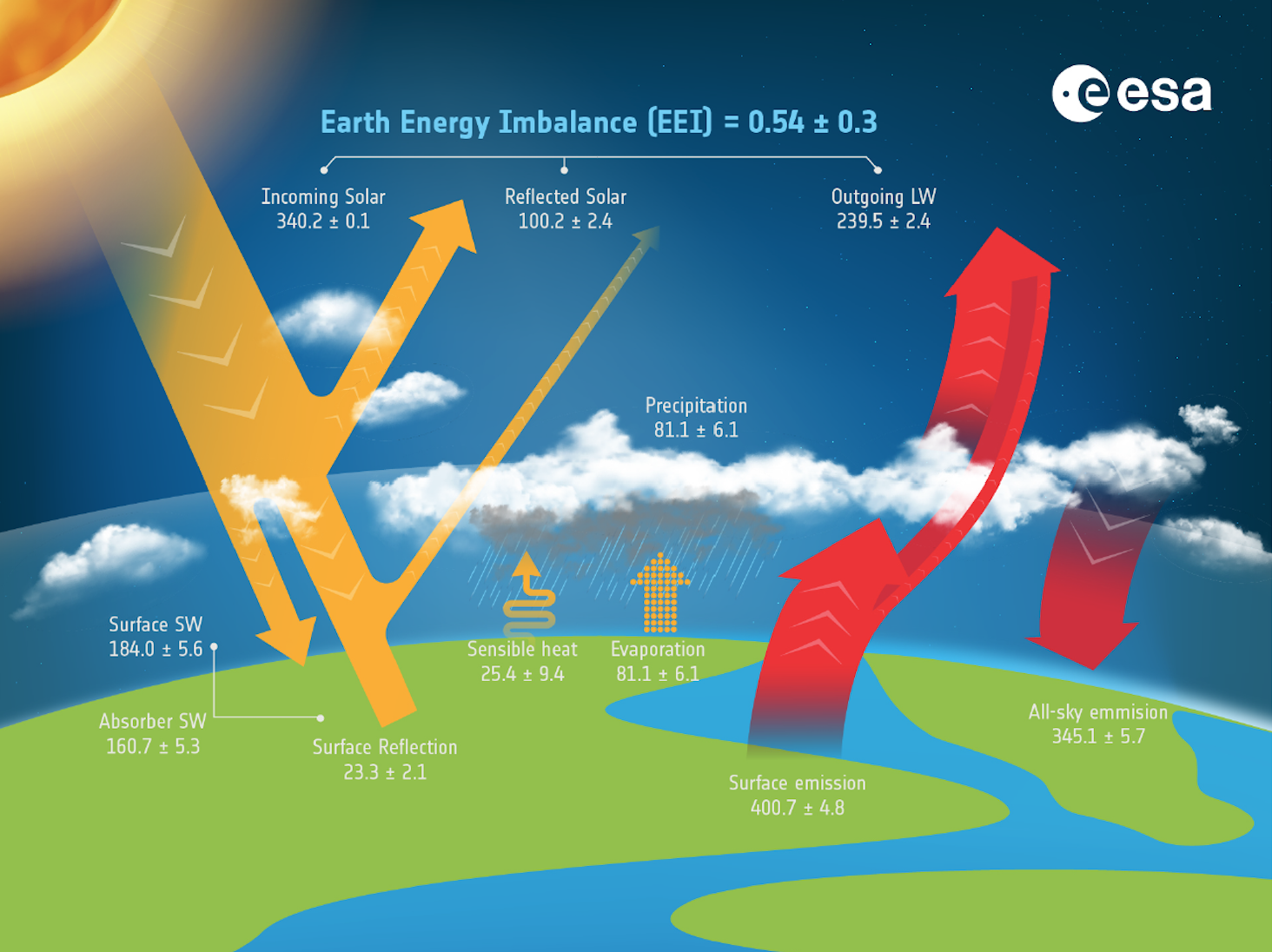About
Summary
This project aims to enhance understanding of the global energy cycle and its dynamics amid anthropogenic climate change. Satellite climate data records developed through ESA’s Climate Change Initiative will aid the estimation of the Earth's Energy Imbalance and analyse the mean, trend, and variability of surface air temperature over the past three decades.
Background
Understanding how the Sun’s energy fuels the global energy cycle and shapes the climate has been a longstanding scientific endeavour (Fourier (1824), Arrhenius (1896) and Dines 1917). Scientists recognised the pivotal role of atmospheric greenhouse gas (GHG) concentrations in the energy cycle during the latter half of the 20th century and raised concerns regarding the impact of anthropogenic emissions on climate.
Earth currently receives approximately 340 W.m⁻² of solar energy, primarily in the visible spectrum (see adapted from Stephens et al., 2023). In total, Earth absorbs about 240 W.m⁻² of solar radiation at the top of the atmosphere (TOA) and emits approximately 239.5 W.m⁻² as infrared radiation back to space, leaving a persistent positive radiation imbalance of 0.5 to 1 W.m⁻² (though this value is subject to significant uncertainty). This latter figure is known as the Earth Energy Imbalance (EEI) and is the driving force behind global warming.

The response of Earth’s climate system to anthropogenic GHG emissions is governed by global climate feedback mechanisms, including Planck feedback, water vapour feedback, lapse rate feedback, and surface albedo feedback, as well as the climate sensitivity parameter. Quantifying these factors is one of the most critical challenges in climate change science.
Aims and Objectives
This project focuses on the simultaneous estimation of the Earth Energy Imbalance (EEI) and surface air temperature (TAS), including their mean, trends, and variability, with reliable uncertainties derived from the European Space Agency’s Climate Change Initiative’s Essential Climate Variable datasets. This allows for a detailed characterisation of the global energy cycle and its responses to anthropogenic GHG emissions.
The EEI and TAS are critical to understanding the global energy cycle. By estimating these variables, this project aims to disentangle the contributions of radiative forcing, climate feedbacks, and internal variability to the climate system’s response to GHG emissions. Expanding and refining EEI and TAS records will reveal how the Earth’s energy budget changes over time.
Our objectives include the development of advanced tools to:
- Diagnose changes in EEI and TAS
- Link changes in EEI and TAS to the broader Earth system
- Identifyand quantify processes driving energy cycle changes
This work will provide fresh perspectives on four key scientific questions:
- Quantification of the EEI Mean, Trend, and Variability:
Constraining the TOA radiation budget on interannual to decadal timescales will contribute to the WCRP/GCOS initiative on Earth’s energy, water, and carbon budgets, as well as the UNFCCC's global stocktake initiative. - Simultaneously Estimating EEI and TAS with Uncertainty:
Constraining the range of the global climate feedback parameter and effective climate sensitivity using observational data. - Assessing the Energy Cycle’s Time-Response to GHG Mitigation Policies:
Determining the timeframe required to detect the first physical impacts of GHG mitigation measures, such as those outlined in the Paris Agreement. - Understanding the Regional Impacts of Energy Cycle Changes:
Analysing temporal changes in TAS in the Arctic to quantify the impacts of energy cycle shifts induced by anthropogenic emissions.
Team
The MOTECUSOMA team consists of 9 scientific and industrial partners. The team is organised as follows:
- Magellium: Project Manager, Earth Energy Imbalance (EEI) product development
- Laboratoire d'Etudes Géophysique Océanographie Spatiales (CNRS/LEGOS): Science Leader, coordination of Earth energy Imbalance development and science analyses
- Department of Meteorology, NCEO, University of Reading: Co Science leader, coordination of Surface air Temperature (TAS) development
- National Centre for Earth Observation (NCEO), University of Leicester: Land Surface Temperature
- Danish Meteorological Institute (DMI): Temperature in Ice Zone
- National Oceanography Centre (NOC): Sea Surface Temperature
- Metoffice: Responsible of the production of TAS
- Laboratoire d'Océanographie Physique et Spatiale (CNRS/LOPS): Validation of EEI with in-situ data
- University of Vienna: Atmospheric Heat Content
Contacts
- Science Leader: Benoit Meyssignac
- Project manager: Gilles Larnicol
- Deputy Project manager: Michael Ablain
- ESA Technical Officer: Sarah Connors




